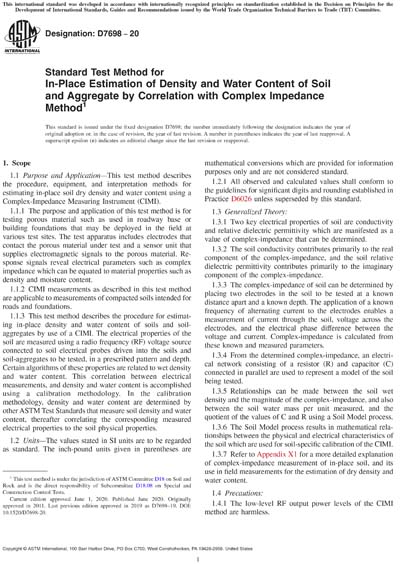Historical
ASTM D7698-20
Standard Test Method for In-Place Estimation of Density and Water Content of Soil and Aggregate by Correlation with Complex Impedance Method
1.1 Purpose and Application—This test method describes the procedure, equipment, and interpretation methods for estimating in-place soil dry density and water content using a Complex-Impedance Measuring Instrument (CIMI).
1.1.1 The purpose and application of this test method is for testing porous material such as used in roadway base or building foundations that may be deployed in the field at various test sites. The test apparatus includes electrodes that contact the porous material under test and a sensor unit that supplies electromagnetic signals to the porous material. Response signals reveal electrical parameters such as complex impedance which can be equated to material properties such as density and moisture content.
1.1.2 CIMI measurements as described in this test method are applicable to measurements of compacted soils intended for roads and foundations.
1.1.3 This test method describes the procedure for estimating in-place density and water content of soils and soil-aggregates by use of a CIMI. The electrical properties of the soil are measured using a radio frequency (RF) voltage source connected to soil electrical probes driven into the soils and soil-aggregates to be tested, in a prescribed pattern and depth. Certain algorithms of these properties are related to wet density and water content. This correlation between electrical measurements, and density and water content is accomplished using a calibration methodology. In the calibration methodology, density and water content are determined by other ASTM Test Standards that measure soil density and water content, thereafter correlating the corresponding measured electrical properties to the soil physical properties.
1.2 Units—The values stated in SI units are to be regarded as standard. The inch-pound units given in parentheses are mathematical conversions which are provided for information purposes only and are not considered standard.
1.2.1 All observed and calculated values shall conform to the guidelines for significant digits and rounding established in Practice D6026 unless superseded by this standard.
1.3 Generalized Theory:
1.3.1 Two key electrical properties of soil are conductivity and relative dielectric permittivity which are manifested as a value of complex-impedance that can be determined.
1.3.2 The soil conductivity contributes primarily to the real component of the complex-impedance, and the soil relative dielectric permittivity contributes primarily to the imaginary component of the complex-impedance.
1.3.3 The complex-impedance of soil can be determined by placing two electrodes in the soil to be tested at a known distance apart and a known depth. The application of a known frequency of alternating current to the electrodes enables a measurement of current through the soil, voltage across the electrodes, and the electrical phase difference between the voltage and current. Complex-impedance is calculated from these known and measured parameters.
1.3.4 From the determined complex-impedance, an electrical network consisting of a resistor (R) and capacitor (C) connected in parallel are used to represent a model of the soil being tested.
1.3.5 Relationships can be made between the soil wet density and the magnitude of the complex-impedance, and also between the soil water mass per unit measured, and the quotient of the values of C and R using a Soil Model process.
1.3.6 The Soil Model process results in mathematical relationships between the physical and electrical characteristics of the soil which are used for soil-specific calibration of the CIMI.
1.3.7 Refer to Appendix X1 for a more detailed explanation of complex-impedance measurement of in-place soil, and its use in field measurements for the estimation of dry density and water content.
1.4 Precautions:
1.4.1 The low-level RF output power levels of the CIMI method are harmless.
1.4.2 The SI units presented for apparatus are substitutions of the inch-pound units, other similar SI units should be acceptable providing they meet the technical requirements established by the inch-pound apparatus.
1.5 This standard does not purport to address all of the safety concerns, if any, associated with its use. It is the responsibility of the user of this standard to establish appropriate safety, health, and environmental practices and determine the applicability of regulatory limitations prior to use.
1.6 This international standard was developed in accordance with internationally recognized principles on standardization established in the Decision on Principles for the Development of International Standards, Guides and Recommendations issued by the World Trade Organization Technical Barriers to Trade (TBT) Committee.
ASTM International [astm]

